
Orquidia Flores-Valenzuela
The Netherlands
August 31, 2007
Originally published in Munting Nayon 125
(December 1999.)
Every story has a beginning and our story begins when a Cavitena accompanied her aunt to sail to another continent. The year was 1947, two years after the end of World War II.
When the ship dropped anchor in The Netherlands, ESTER TALA decided to stay behind and reach for her Tala (Pilipino for star) in the land of windmills.
Determined and full of conviction she will find her fortune in a far-distant land, she took a job as seamstress. Ten years later, she met and married Rinus Jagtenberg.
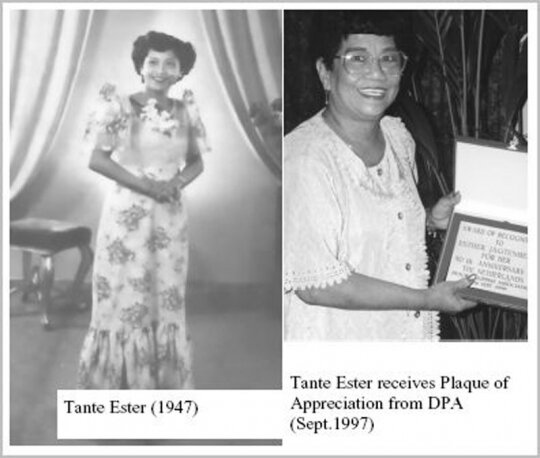
Tante Ester 1947 and 1997
The arrival of the first groups of Filipinas in 1964, changed the social life of the couple. Their week-ends were spent visiting and accompanying them to various places. The newcomers in turn, looked up to Tante Ester as their aunt and sought her comfort and advice.
With the passing away of Oom Rinus, Tante Ester is now surrounded by her Filipina friends who attend to her with the same love and kindness she showed them in their early years.
In 1996, 50 years after she set foot in Holland, they surprised her with a party and a testimonial plaque for humanitarian service. She maintains an active life, socializes and attends community activities and when not at home could be seen enjoying a stroll on the flea market of Amsterdam.
10 YEARS LATER CONCHITA GASTON who had carved out a career for herself in the United States as mezzo soprano, came to Europe to join the roster of an opera company in Antwerp.
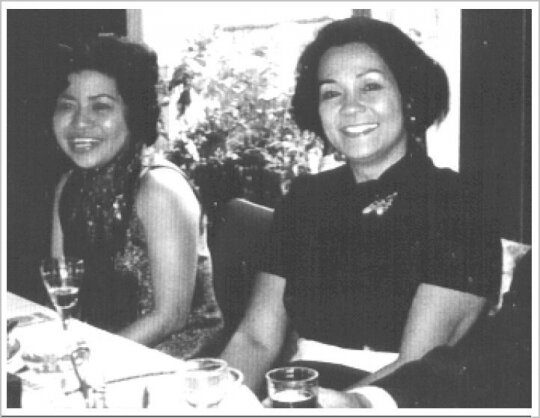
Carmencita Lozada and Conchita Gaston
Philippine ambassadors in The Netherlands and other European countries proudly presented her in many diplomatic functions. Gaston, took these occasions as opportunity for foreigners to hear her native music and her usual final number was "Ay Kalisud," which she sang with gusto and deep feelings of an Ilonga.
She was married to the Dutch director of a concert theater and resided in The Hague until her death.
CARMENCITA LOZADA after graduating from the Music School in Vienna with the highest honours took up residence in The Netherlands in January 1964. The demands of her musical career , however, necessitated her immigration to Germany in 1975,and in the span of more than 30 years she performed in the finest concert halls of Europe, United States, Canada and Asia.
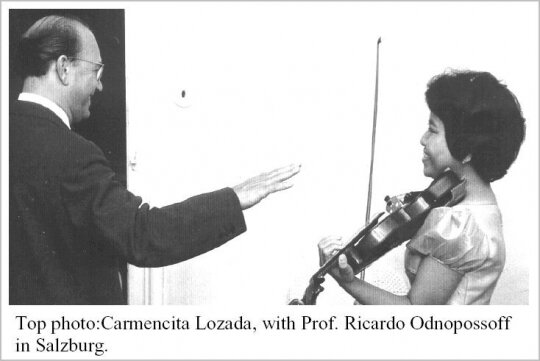
Carmencita Lozada with Prof. Ricardo Odnopossoff in Salzburg
This violinist considers The Netherlands as her second home and continues concertizing in the country: in 1994, for Samahan, a migrant workers' association; in 1997 she inspired the young music students by opening and closing the programme of Munting Nayon's "Afternoon of Music"; and a few months later in a solo concert in the Concert Theatre in Amsterdam.
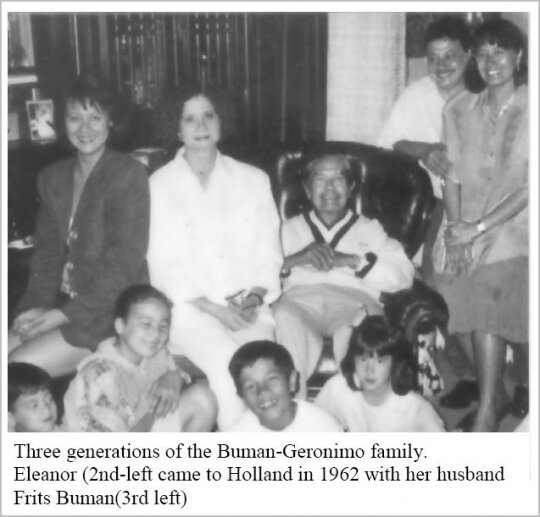 She and Conchita Gaston played solo or together on different occasions for the Philippine embassies, every performance a showcase of Philippine culture.
She and Conchita Gaston played solo or together on different occasions for the Philippine embassies, every performance a showcase of Philippine culture.
NEWLY-MARRIED BRIDES during this period, arrived with their Dutch husbands: ELEANOR GERONIMO, with her husband Frits Buman and their one-year-old daughter from New Guinea where her husband was assigned by Shell; another bride was an Ilonga and the third was from a prominent family in Manila.
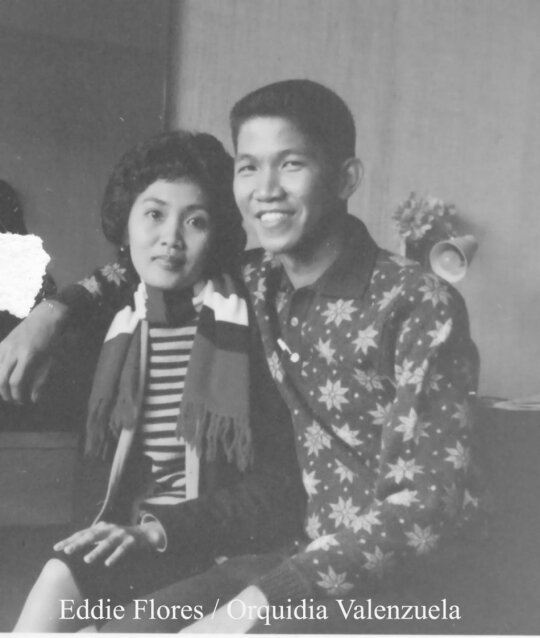
Orquid Valenzuela and Eddie Flores - The Hague 1966
In DECEMBER 1965, a young couple, EDDIE FLORES and ORQUIDIA VALENZUELA, left the Philippines for The Netherlands where the wife was assigned by the Department of Foreign Affairs as secretary in the Philippine Embassy in The Hague. Upon arrival, Flores went to the Labour Bureau and was warmly received by an officer. It turned out he had a long list of vacancies to fill. The country’s manpower was not enough to cope up with the industrial acceleration and the poor guy was practically at the end of his wits, when Flores appeared. He could not care less who or where this brown guy came from, he had an applicant, that was enough. He served him coffee and in the course of the interview told Flores he may be the first Filipino to join the labour force of the country. He chose for him an American multinational company.
Ten years later, Valenzuela was recalled to the Home Office but the political turmoil in the Philippines and the deteriorating economic condition, plus the fact that the family was separated, convinced the couple that it was in their best interest that the family settle in The Netherlands.
As the years passed, the couple noted the population of Filipinos in this country was rapidly growing but there was lack of sufficient information from home and that which affects their own countrymen in Holland and nearby countries. In 1988, the couple, (together with Jorge Carreon) pioneered the publication of the first Filipino community news-information magazine, Munting Nayon. In 1991, Jorge left Munting Nayon.
ARRIVALS IN WAVES - DOCTORS, NURSES, MIDWIVES, SEAMSTRESSES, ENTERTAINERS
When the then Princess Beatrix visited the Philippines she noted the high percentage of graduates in the medical field. Returning home from her trip she told the Dutch hospital authorities of the great number of English-speaking nurses which the Philippines can supply. Among the sectors that lacked personnel were the hospitals and contract-nurses from another country may be the solution. Without much ado, the proposal to employ Philippine nurses was approved.
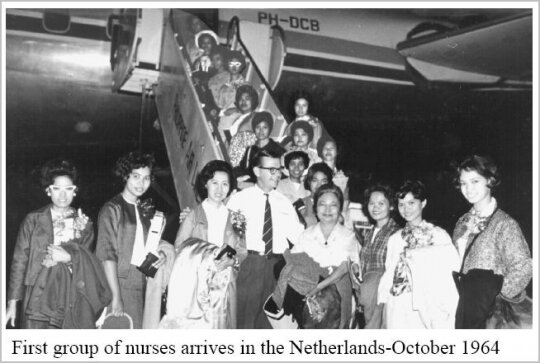
First group of nurses arrives in the Netherlands-October 1964
Two groups of Philippine nurses with an employment contract for three years arrived in 1964. All nurses were assigned in the university hospital in Utrecht.
Twenty-nine more nurses were recruited in 1965 for Leiden university hosptal. Many of these nurses had specialized in certain areas and held responsible positions in various hospitals in the United States, Canada and even in the Philippines but they were lured by the beauty of Europe which they have only seen in movies and the thrilling adventures in another continent.
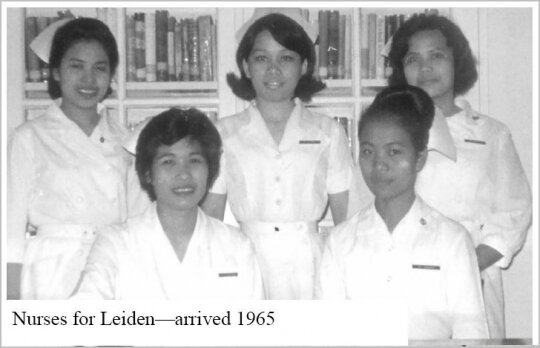
Nurses for Leiden-arrived 1965
A few days after they arrived, the nurses' excitement turned to shock when told serving coffee, cleaning and dusting their wards were included in their work. Resentments and disagreements ensued.
In the negotiations in Manila, no one among the concerned parties, officials and the nurses themselves, foresaw a major problem to come up. Never did it cross their minds that there may be differences in the standard of the nursing profession in their countries. The signing went off without a hitch, in good faith and friendly atmosphere.
To prevent further escalation of the problem, hospital officials and the Philippine Ambassador Delfin R. Garcia and Minister Petronilo Dulay met and in the discussions, the diplomats proposed the employment of midwives to do practical nurse work.
The registered nurses were given the option to break or finish their contract. Half of them left for the United States and Canada before their term ended.
The Dutch hospital authorities again went to the Philippines, this time to recruit midwives.
AROUND THIS TIME, three doctors arrived, Dr. Elizabeth Malonga, surgeon; Dr. Erlinda Villanueva from her specialization in obstetrics-gynecology at Mt. Sinai in the United States; and Dr. Zenaida Manago, anesthesiologist who had to stop working early due to illness. All three started at St. Lukas Ziekenhuis.
Dr. Malonga was later connected with Academisch Medisch Centrum until her retirement.
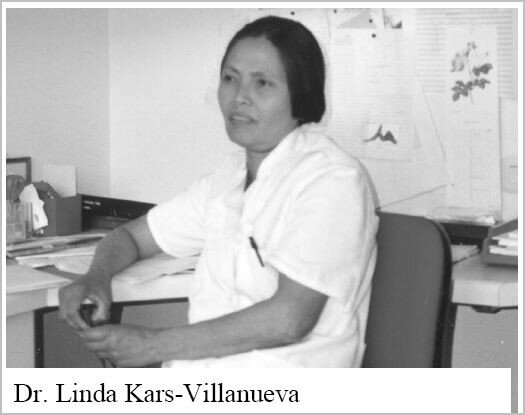
Dr. Linda Kars-Villanueva
Dr. Villanueva upon arrival, was designated Chief of Polyclinic at St. Lukas and held this position until her transfer to Zeeweg hospital in Ijmuiden where she headed the Obstetric-Gynecology Department. Married to Dr. Peter Kars, she retired recently before reaching pension age and now gives time to activities that help her countrymen.
Dr. Malong and Dr. Villanueva, have been recognized top specialists in their respective fields not only in Holland but also abroad.
Dr. Angela Lauchengo, an anesthesiologist arrived from her specialization in Denmark but left in 1977. Other doctors also did not stay long. Dr. Eduardo Cruz arrived from his practice in Netherlands Antilles some years ago and is presently connected with the Heart Center in Rotterdam.
THE FIRST BATCH OF 25 MIDWIVES
They arrived on August 2, 1967 accompanied by Dr. Hattinga Vershure, followed a week later by a group of 25 guided by Sr. Doorenbosch to work in St. Lucas hospital in Amsterdam. Onze Lieve Vrouw hospital in Amsterdam also welcomed its first midwives and after a week another batch arrived..
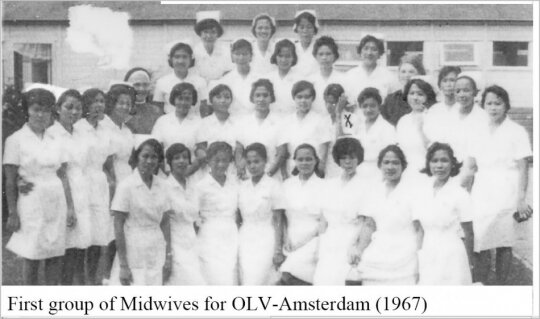
First group of Midwives for OLV-Amsterdam (1967)
Midwife doing the job of a practical nurse was undoubtedly the satisfactory solution. Both hospital and the Filipina midwives were happy. No problem arose after this. Other hospitals like Binnenziekenhuis in Eindhoven, Lutherse Diaconessen, Majella in Bussum, in Haarlem, etc., sent their representatives to contract Philippine midwives, and the recruitment continued up to 1971. A few registered nurses and medical technologists applied and joined the midwives.
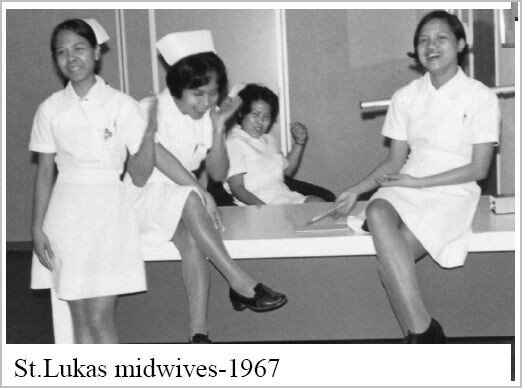
St. Lukas midwives
In their first year, there were miscommunications between the Filipinas and the patients because of the language to the amusement of their Dutch colleagues and even the patients themselves. The nurses were challenged, they were to show the Dutch the high quality of their performance, they took orientation and language courses seriously. To the surprise of the hospital authorities, in no time they could carry on conversations with the patients and remarkably adjusting to their new environment.
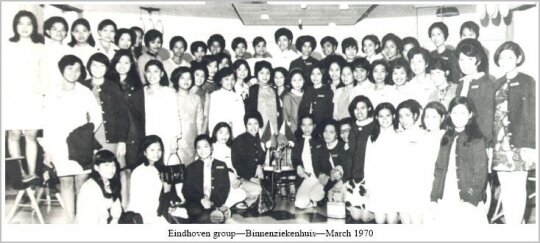
Eindhoven group -Binnenziekenhuis - March 1970
Their stories were carried by newspapers all over the country, the petite lasses who came from a country near Indonesia, the Dutch patients' praises for their tenderness and happy disposition, and positive comments of the doctors for their efficiency and good camaraderie.
Unlike the nurses, a great number of the midwives extended their contract and married Dutch men, eventually acquiring Dutch citizenship. There were also those who met Filipino sailors on foreign-flag carriers plying between Asia and Europe. Those who left boyfriends in the Philippines petitioned for them so they can come.
Princess Beatrix's trip further strengthened the friendly relations between the nations, the Philippines, a developing country rich in medical professionals and The Netherlands, a developed nation in dire need of manpower.
The Philippine government which was represented only by a legation, was elevated into an embassy before 1965.
NEW BATCH OF FILIPINO NURSES
In the late 90’s , The Netherlands’ health sector sounded alarm in their shortage of personnel thereby initiating recruitments of nurses from outside their border.
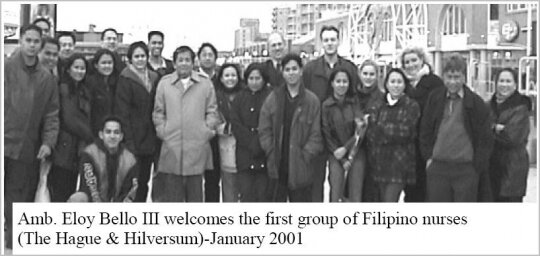
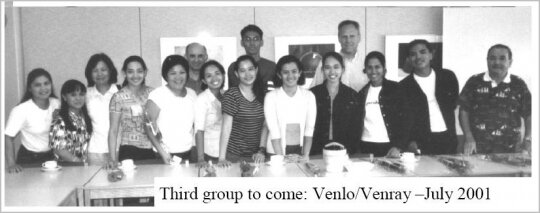
Third group to come: Venlo/Venray - July 2001
In the January 2001, the first batch of 19 nurses from the Philippines arrived to work in The Hague and Hilversum. Since then, 2 groups followed and the latest arrival was last July when 9 Filipino nurses came to start their work in Venlo and Venray.
SCHOLARS - When a bilateral agreement was signed by the Netherlands and the Philippines, about 30 years ago, Filipino professionals working with the government and in the private sectors have been given the opportunity to further or advance their studies at the Institute of Social Studies (ISS) in The Hague, International Training Center Delft (ITC) in Delft, in Wageningen for agriculture, Housing Institute in Rotterdam, in Enschede, etc. Because of the unstable condition prevailing in the Philippines during the Marcos regime, there were some who paid back their offices for the expenses incurred for them and stayed in this country.
FILIPINA SEAMSTRESSES for the Berghaus factory in Gendringen, the idea struck Verius Croonen, Personnel Manager of Berghaus, when he came across a newspaper article on the new nurses from the Philippines.
Croonen sought his brother's help, a Catholic missionary in Guimba, Nueva Ecija. Fr. Croonen had no difficulty looking for applicants. He was immediately swarmed by the lasses from the town when he broke the news that a garment factory in Holland wanted to employ seamstresses. Another Dutch priest, Fr. Lagerwey, head of the Social Communications Center in Manila, provided office space for the applicants’ registration and staff to supervise the aptitude test.
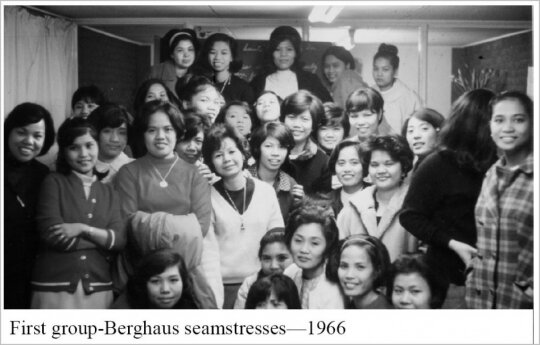
First group-Berghaus seamstresses -1966
In March 1966, the first group of around 60 arrived and were housed in a row of apartments in Gendringen. Though they had no previous sewing experience, they proved to be efficient workers which encouraged the company to recruit additional seamstresses providing them with living quarters in Ulft and Wehl. Every year, from 1966, a group of about 60 came headed by a Filipina social worker and was replaced at end of the three-year-contract. Berghaus provided the food and lodging, the costs deducted from the seamstresses' salary.
A Richard Burton-look-alike Catholic priest in his early 40s, Fr. Josef van Dooren was assigned to be the spiritual counselor of all the groups in Achterhoek. When he learnt the "girls" as he called them, had only a net of about 60 guilders a week and from the amount deducted support to their families, he appointed himself the girls' "chauffeur", packing five or six of them in his beetle and drove them around the country and nearby Germany. Often, he did errands for them.
As its business prospered Berghaus decided to employ Filipinas for their factory and office in Amsterdam. Again, they arrived in groups, each group with a social worker, and placed in the newly-built apartments in Bijlmermeer.
Unlike the nurses and midwives, those hired by Berghaus had very little in common with each other. Their ages ranged from 18 to 29 years, many came from the countryside, others from the metropolis with different educational and social backgrounds. Seven to nine occupied one apartment sharing the kitchen, toilet and bathroom. To say that there were no frictions and clashes, especially in their first year will be dishonest, yet every group finished its contract without major injuries or disaster, a miracle of ingenuity of Filipinas.
In 1972 Berghaus recruited for the last time.
One Dutch couple who played a big role in the lives of many workers in Berghaus were Ateng van de Worm and her husband Kaka. Their warm friendship and generosity have touched the hearts of the Filipinas.
Marriages of Filipinas and Dutch took place in the Achterhoek and Amsterdam at the end of their Berghaus' contract. A big number in Amsterdam married countrymen whose ships docked in Rottedam and Amsterdam.
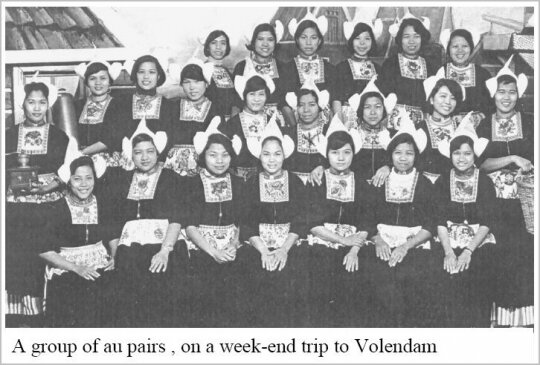
A group of au pairs, on a week-end trip to Volendam
In 1967 ENTERTAINERS were recruited by Conti Productions for a nightclub in Amsterdam. These were professional artists who danced native numbers in modern Philippine costumes. As the economic situation in the Philippines deteriorated, the number of applicants for the job increased, many came contracted by clubs for several months, a number took the chance of coming without a job but somehow found employment. These entertainers have eventually integrated into the Dutch society.
DUTCH VOLUNTEERS for The Netherlands Technical Assistance Program to developing countries were sent to the Philippines and were assigned to various parts of the nation to give technical training to young Filipinos. The fair-skin bachelors fell in love with charming and witty Filipinas and when their term ended, the volunteers came back with their brides.
THE MARCOS ERA
As Marcos continued to take the law into his hands, suspend the writ of habeas corpus and persecuted and tortured his opponents, The Netherlands, which has been internationally known and respected as a champion of human rights, started to receive appeals for political asylum.
In 1976, Luis Jalandoni and his wife Cony Ledesma, with their infant son, were the first Filipino political refugees to come to The Netherlands.
For Filipinos, The Netherlands 30 years ago was not considered a priority land for migration. The nurses, midwives and seamstresses left after their contract extract for the United States and Canada., with the exception of a few hundreds who opted to remain. Suddenly, these Filipinos realized they were bumping into new faces in the open markets, shopping malls, even in streets. Family members or friends came with the hope of getting employment, a big number of them were hired in the service of diplomats, others in rigs, ships, hotels and the very lucky landed office positions.
Some young people who corresponded with foreigners as hobby ended marrying their pen-pals and so by word of mouth, pen-pal gained popularity. It must have been this that gave Koos van der Kaay and his wife Conchita Talaga the idea to establish the first match-making agency in the early 80s which they named "Conchita Pen-Pal Club."
The number of couples who availed of the services of Conchita's club and other agencies with the same business that followed in later years, and the success of such a marriage, is anyone's guess but it is a fact that many inter-marriages between Dutch and Filipinas were the result of Conchita Pen-Pal club.
In the 90s another means of earning money for young Filipinas was found, through the au pair program. Au pair agencies began to blossom. Dutch families welcome Filipina au pairs because of their knowledge of English and reliability.
It is estimated that since the program started, approximately 2000 came to the Netherlands. A number of them have married and settled here while others transferred to other European countries.
In 1995 the Philippine government placed a ban on the au pair program, but The Netherlands government recognizes the program and imposes no restrictions, Filipinas who are under 25 years old, still come although now, in lesser number.
The influx of countrymen in all walks of life in Holland had reached a new level.
ORGANIZATIONS & FOUNDATIONS, RELIGIOUS GROUPS
With the increase in their population, Filipinos formed their respective religious group and service. Filipino Catholics who used to attend Dutch mass, have organized themselves and were able to get either a Filipino or English-speaking priest to say mass at least one Sunday in the month in their respective areas. Other religious groups, for example, Iglesia ni Kristo which started its worship service in October 1983, Word International Ministries, Jesus is Lord, hold their own services.
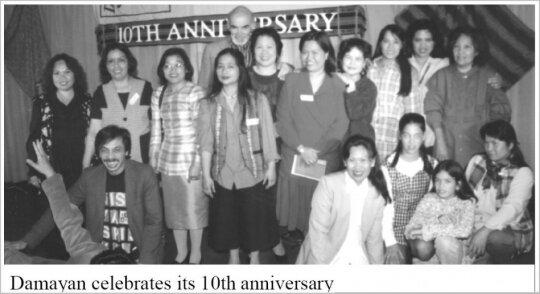
Damayan celebrates its 10th anniversary
In the beginning associations and clubs were for cultural and social purposes only. In the case of the Philippine Nurses Association of the Academisch Ziekenhuis in Leiden formed in 1965, it had an exclusive membership. The first Dutch and Filipino club, the Dutch-Philippine Club was established in Gendringen in 1973. Six years later, Dutch-Philippine Association (DPA) in Utrecht was formed. DPA, however, is not an offshoot of the Dutch-Philippine Club of 1973. Some of the major sports and/or cultural associations are Barangay , United Filipino-Dutch Association and Filipino Sports Club.
The changes in immigration laws and labour market in the European Community, not to mention the adjustments to a new environment and family life more so in inter-racial marriage, are some of the problems Filipino(a)s, have to cope with. There are several associations and foundations geared for such cases, like Samahan ng Manggagawang Pilipino, Damayan, United Filipino Seafarers, Migrante, Bayanihan, Pinay sa Holland, Kababaihang Pilipina, etc.
At present, there are more than 20 associations of Filipinos and Dutch and Filipinos, with at least one in every province.
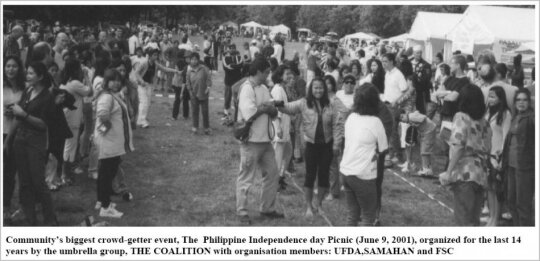
The population of Filipinos in The Netherlands has grown by leaps and bounds over the years, no one can be sure of the actual number, some give an educated guess of 12,000.
They have assimilated to the culture and system of the country and majority has acquired its nationality, but at heart they remain Filipinos, no document can change that.
Their sterling qualities: the readiness to help not only their families but any country(wo)man in need, and respect and tolerance for each other’s religious beliefs and political ideologies. The Filipinos in The Netherlands have a cohesive Community
Munting Nayon-Special Issue History of the Filipino Community in the Netherlands October 15, 2001
See Also:
 GERMAN CITIES OF DRESDEN, LEIPZIG AND SAXONY REGION
GERMAN CITIES OF DRESDEN, LEIPZIG AND SAXONY REGION
August 9 – 16, 2014: Twenty five years after West and East Germany reunited into one nation we were finally...
 SISTER MARY VISITACION CELEBRATES 25th YEAR OF CONTEMPLATIVE LIFE
SISTER MARY VISITACION CELEBRATES 25th YEAR OF CONTEMPLATIVE LIFE
She was in her twenties when Milagros Olaño Castrodes entered the convent in Cebu of the Order of Holy Spirit...
 SIBOL SCHOOLYEAR 2013-2014 PREP- EDU. IN DON MANUEL VILLAGE
SIBOL SCHOOLYEAR 2013-2014 PREP- EDU. IN DON MANUEL VILLAGE
This school year, 2013-2014, 35 children between three to six years old in the poor village of Don Manuel, Barangay...
 PCCF Little Miss Philippines Canada 2018 Pre-Pageant
PCCF Little Miss Philippines Canada 2018 Pre-Pageant
May 5-TORONTO, ONTARIO, CANADA - The Little Miss Philippines Canada 2018 candidates of the Philippine Canadian Charitable Foundation (PCCF) showcased their talents and beauty during the Pre-Pageant show held May 5th at the Korean Cultural Centre in Toronto....
 APM MUSIKAHAN 2018 IDINAOS SA PHILIPPINE EMBASSY SA RIYADH
APM MUSIKAHAN 2018 IDINAOS SA PHILIPPINE EMBASSY SA RIYADH
Riyadh-May 4: Matagumpay na naitanghal ng Asosasyon ng mga Pilipinong Mang-aawit (APM) ang “Musikahan 2018: The Champions’ Showdown!” sa chancery ng Philippine Embassy sa Riyadh (Saudi Arabia) noong ika-4 ng Mayo, 2018....
 Ang Negrosanon in North America’s New Set of Officers Aim for Active Community Relations and Growth in Membership
Ang Negrosanon in North America’s New Set of Officers Aim for Active Community Relations and Growth in Membership
Ang Negrosanon in North America in a hot day of 27 degrees and scattered rain showers in the evening rush...
 Bicol Canada Community Association Holds Spring Gala & Officers Induction
Bicol Canada Community Association Holds Spring Gala & Officers Induction
Scarborough-May 4: Like the majestic Mayon Volcano, the Oragons and the Magayons of Bikolandia conducted their meaningful gathering...
 AGAPI marks ANZAC Day with prayers, flowers, songs
AGAPI marks ANZAC Day with prayers, flowers, songs
The Association of Golden Australian Pilipinos Inc (AGAPI) marked one of the pivotal events in Australian history through prayer, song...
 Our “People of the Sea”
Our “People of the Sea”
BERN, Switzerland – A luxury ship cruise is associated with pleasure and fun and merrymaking. And this month we were...
 Association of Filipino Conservatives of Canada (AFCC) Hold First Major Event
Association of Filipino Conservatives of Canada (AFCC) Hold First Major Event
Newly Minted Fil-Can Organization Aims to Get More Filipinos Involved in All Levels of Canadian Governance.
...
 `CON AMOR’ FOUNDATION B0ARD MEMBERS VISIT PROJECTS IN PHILIPPINES
`CON AMOR’ FOUNDATION B0ARD MEMBERS VISIT PROJECTS IN PHILIPPINES
Businessman Jaap van Dijke, chairman and two board members, Myrla Danao and Dr. John Deen of Con Amor foundation in...
 THE CHILDREN IN DON MANUEL GK VILLAGE
THE CHILDREN IN DON MANUEL GK VILLAGE
Sixty-three children from age three to six years, in the very poor community of Don Manuel village in Barangay...
 History of the Filipino Community in the Netherlands
History of the Filipino Community in the Netherlands
Every story has a beginning and our story begins when a Cavitena accompanied her aunt to sail to another continent....
 Art Creations
Art Creations
Welcome!
Many believe formal training is a prerequisite to quality in painting. Not a few will agree with me one can...
Disclaimer
Contents posted in this site, muntingnayon.com, are the sole responsibility of the writers and do not reflect the editorial position of or the writers' affiliation with this website, the website owner, the webmaster and Munting Nayon News Magazine.
This site, muntingnayon.com, the website owner, the webmaster and Munting Nayon News Magazine do not knowingly publish false information and may not be held liable for any direct, indirect, incidental, consequential or punitive damages arising for any reason whatsoever from this website or from any web link used in this site.


29 years
of
Community Service
of
Community Service
MUNTING NAYON
News Magazine
Operated by couple Eddie Flores and Orquidia Valenzuela
News and Views of the
Filipino Community Worldwide
Filipino Community Worldwide
History of the Filipino Community in the Netherlands
Orquidia Flores-Valenzuela
The Netherlands
August 31, 2007
Originally published in Munting Nayon 125
(December 1999.)
Every story has a beginning and our story begins when a Cavitena accompanied her aunt to sail to another continent. The year was 1947, two years after the end of World War II.
When the ship dropped anchor in The Netherlands, ESTER TALA decided to stay behind and reach for her Tala (Pilipino for star) in the land of windmills.
Determined and full of conviction she will find her fortune in a far-distant land, she took a job as seamstress. Ten years later, she met and married Rinus Jagtenberg.

With the passing away of Oom Rinus, Tante Ester is now surrounded by her Filipina friends who attend to her with the same love and kindness she showed them in their early years.
In 1996, 50 years after she set foot in Holland, they surprised her with a party and a testimonial plaque for humanitarian service. She maintains an active life, socializes and attends community activities and when not at home could be seen enjoying a stroll on the flea market of Amsterdam.
10 YEARS LATER CONCHITA GASTON who had carved out a career for herself in the United States as mezzo soprano, came to Europe to join the roster of an opera company in Antwerp.

Philippine ambassadors in The Netherlands and other European countries proudly presented her in many diplomatic functions. Gaston, took these occasions as opportunity for foreigners to hear her native music and her usual final number was "Ay Kalisud," which she sang with gusto and deep feelings of an Ilonga.
She was married to the Dutch director of a concert theater and resided in The Hague until her death.
CARMENCITA LOZADA after graduating from the Music School in Vienna with the highest honours took up residence in The Netherlands in January 1964. The demands of her musical career , however, necessitated her immigration to Germany in 1975,and in the span of more than 30 years she performed in the finest concert halls of Europe, United States, Canada and Asia.

This violinist considers The Netherlands as her second home and continues concertizing in the country: in 1994, for Samahan, a migrant workers' association; in 1997 she inspired the young music students by opening and closing the programme of Munting Nayon's "Afternoon of Music"; and a few months later in a solo concert in the Concert Theatre in Amsterdam.

Three generations of the Buman-Geronimo family. Eleanor (2nd-left came to Holland in 1962 with her husband Frits Buman(3rd left)
NEWLY-MARRIED BRIDES during this period, arrived with their Dutch husbands: ELEANOR GERONIMO, with her husband Frits Buman and their one-year-old daughter from New Guinea where her husband was assigned by Shell; another bride was an Ilonga and the third was from a prominent family in Manila.

Ten years later, Valenzuela was recalled to the Home Office but the political turmoil in the Philippines and the deteriorating economic condition, plus the fact that the family was separated, convinced the couple that it was in their best interest that the family settle in The Netherlands.
As the years passed, the couple noted the population of Filipinos in this country was rapidly growing but there was lack of sufficient information from home and that which affects their own countrymen in Holland and nearby countries. In 1988, the couple, (together with Jorge Carreon) pioneered the publication of the first Filipino community news-information magazine, Munting Nayon. In 1991, Jorge left Munting Nayon.
ARRIVALS IN WAVES - DOCTORS, NURSES, MIDWIVES, SEAMSTRESSES, ENTERTAINERS
When the then Princess Beatrix visited the Philippines she noted the high percentage of graduates in the medical field. Returning home from her trip she told the Dutch hospital authorities of the great number of English-speaking nurses which the Philippines can supply. Among the sectors that lacked personnel were the hospitals and contract-nurses from another country may be the solution. Without much ado, the proposal to employ Philippine nurses was approved.

Two groups of Philippine nurses with an employment contract for three years arrived in 1964. All nurses were assigned in the university hospital in Utrecht.
Twenty-nine more nurses were recruited in 1965 for Leiden university hosptal. Many of these nurses had specialized in certain areas and held responsible positions in various hospitals in the United States, Canada and even in the Philippines but they were lured by the beauty of Europe which they have only seen in movies and the thrilling adventures in another continent.

A few days after they arrived, the nurses' excitement turned to shock when told serving coffee, cleaning and dusting their wards were included in their work. Resentments and disagreements ensued.
In the negotiations in Manila, no one among the concerned parties, officials and the nurses themselves, foresaw a major problem to come up. Never did it cross their minds that there may be differences in the standard of the nursing profession in their countries. The signing went off without a hitch, in good faith and friendly atmosphere.
To prevent further escalation of the problem, hospital officials and the Philippine Ambassador Delfin R. Garcia and Minister Petronilo Dulay met and in the discussions, the diplomats proposed the employment of midwives to do practical nurse work.
The registered nurses were given the option to break or finish their contract. Half of them left for the United States and Canada before their term ended.
The Dutch hospital authorities again went to the Philippines, this time to recruit midwives.
AROUND THIS TIME, three doctors arrived, Dr. Elizabeth Malonga, surgeon; Dr. Erlinda Villanueva from her specialization in obstetrics-gynecology at Mt. Sinai in the United States; and Dr. Zenaida Manago, anesthesiologist who had to stop working early due to illness. All three started at St. Lukas Ziekenhuis.
Dr. Malonga was later connected with Academisch Medisch Centrum until her retirement.

Dr. Villanueva upon arrival, was designated Chief of Polyclinic at St. Lukas and held this position until her transfer to Zeeweg hospital in Ijmuiden where she headed the Obstetric-Gynecology Department. Married to Dr. Peter Kars, she retired recently before reaching pension age and now gives time to activities that help her countrymen.
Dr. Malong and Dr. Villanueva, have been recognized top specialists in their respective fields not only in Holland but also abroad.
Dr. Angela Lauchengo, an anesthesiologist arrived from her specialization in Denmark but left in 1977. Other doctors also did not stay long. Dr. Eduardo Cruz arrived from his practice in Netherlands Antilles some years ago and is presently connected with the Heart Center in Rotterdam.
THE FIRST BATCH OF 25 MIDWIVES
They arrived on August 2, 1967 accompanied by Dr. Hattinga Vershure, followed a week later by a group of 25 guided by Sr. Doorenbosch to work in St. Lucas hospital in Amsterdam. Onze Lieve Vrouw hospital in Amsterdam also welcomed its first midwives and after a week another batch arrived..

Midwife doing the job of a practical nurse was undoubtedly the satisfactory solution. Both hospital and the Filipina midwives were happy. No problem arose after this. Other hospitals like Binnenziekenhuis in Eindhoven, Lutherse Diaconessen, Majella in Bussum, in Haarlem, etc., sent their representatives to contract Philippine midwives, and the recruitment continued up to 1971. A few registered nurses and medical technologists applied and joined the midwives.

In their first year, there were miscommunications between the Filipinas and the patients because of the language to the amusement of their Dutch colleagues and even the patients themselves. The nurses were challenged, they were to show the Dutch the high quality of their performance, they took orientation and language courses seriously. To the surprise of the hospital authorities, in no time they could carry on conversations with the patients and remarkably adjusting to their new environment.

Their stories were carried by newspapers all over the country, the petite lasses who came from a country near Indonesia, the Dutch patients' praises for their tenderness and happy disposition, and positive comments of the doctors for their efficiency and good camaraderie.
Unlike the nurses, a great number of the midwives extended their contract and married Dutch men, eventually acquiring Dutch citizenship. There were also those who met Filipino sailors on foreign-flag carriers plying between Asia and Europe. Those who left boyfriends in the Philippines petitioned for them so they can come.
Princess Beatrix's trip further strengthened the friendly relations between the nations, the Philippines, a developing country rich in medical professionals and The Netherlands, a developed nation in dire need of manpower.
The Philippine government which was represented only by a legation, was elevated into an embassy before 1965.
NEW BATCH OF FILIPINO NURSES
In the late 90’s , The Netherlands’ health sector sounded alarm in their shortage of personnel thereby initiating recruitments of nurses from outside their border.

Amb. Eloy Bello III welcomes the first group of Filipino nurses (The Hague & Hilversum)-January 2001

In the January 2001, the first batch of 19 nurses from the Philippines arrived to work in The Hague and Hilversum. Since then, 2 groups followed and the latest arrival was last July when 9 Filipino nurses came to start their work in Venlo and Venray.
SCHOLARS - When a bilateral agreement was signed by the Netherlands and the Philippines, about 30 years ago, Filipino professionals working with the government and in the private sectors have been given the opportunity to further or advance their studies at the Institute of Social Studies (ISS) in The Hague, International Training Center Delft (ITC) in Delft, in Wageningen for agriculture, Housing Institute in Rotterdam, in Enschede, etc. Because of the unstable condition prevailing in the Philippines during the Marcos regime, there were some who paid back their offices for the expenses incurred for them and stayed in this country.
FILIPINA SEAMSTRESSES for the Berghaus factory in Gendringen, the idea struck Verius Croonen, Personnel Manager of Berghaus, when he came across a newspaper article on the new nurses from the Philippines.
Croonen sought his brother's help, a Catholic missionary in Guimba, Nueva Ecija. Fr. Croonen had no difficulty looking for applicants. He was immediately swarmed by the lasses from the town when he broke the news that a garment factory in Holland wanted to employ seamstresses. Another Dutch priest, Fr. Lagerwey, head of the Social Communications Center in Manila, provided office space for the applicants’ registration and staff to supervise the aptitude test.

In March 1966, the first group of around 60 arrived and were housed in a row of apartments in Gendringen. Though they had no previous sewing experience, they proved to be efficient workers which encouraged the company to recruit additional seamstresses providing them with living quarters in Ulft and Wehl. Every year, from 1966, a group of about 60 came headed by a Filipina social worker and was replaced at end of the three-year-contract. Berghaus provided the food and lodging, the costs deducted from the seamstresses' salary.
A Richard Burton-look-alike Catholic priest in his early 40s, Fr. Josef van Dooren was assigned to be the spiritual counselor of all the groups in Achterhoek. When he learnt the "girls" as he called them, had only a net of about 60 guilders a week and from the amount deducted support to their families, he appointed himself the girls' "chauffeur", packing five or six of them in his beetle and drove them around the country and nearby Germany. Often, he did errands for them.
As its business prospered Berghaus decided to employ Filipinas for their factory and office in Amsterdam. Again, they arrived in groups, each group with a social worker, and placed in the newly-built apartments in Bijlmermeer.
Unlike the nurses and midwives, those hired by Berghaus had very little in common with each other. Their ages ranged from 18 to 29 years, many came from the countryside, others from the metropolis with different educational and social backgrounds. Seven to nine occupied one apartment sharing the kitchen, toilet and bathroom. To say that there were no frictions and clashes, especially in their first year will be dishonest, yet every group finished its contract without major injuries or disaster, a miracle of ingenuity of Filipinas.
In 1972 Berghaus recruited for the last time.
One Dutch couple who played a big role in the lives of many workers in Berghaus were Ateng van de Worm and her husband Kaka. Their warm friendship and generosity have touched the hearts of the Filipinas.
Marriages of Filipinas and Dutch took place in the Achterhoek and Amsterdam at the end of their Berghaus' contract. A big number in Amsterdam married countrymen whose ships docked in Rottedam and Amsterdam.

In 1967 ENTERTAINERS were recruited by Conti Productions for a nightclub in Amsterdam. These were professional artists who danced native numbers in modern Philippine costumes. As the economic situation in the Philippines deteriorated, the number of applicants for the job increased, many came contracted by clubs for several months, a number took the chance of coming without a job but somehow found employment. These entertainers have eventually integrated into the Dutch society.
DUTCH VOLUNTEERS for The Netherlands Technical Assistance Program to developing countries were sent to the Philippines and were assigned to various parts of the nation to give technical training to young Filipinos. The fair-skin bachelors fell in love with charming and witty Filipinas and when their term ended, the volunteers came back with their brides.
THE MARCOS ERA
As Marcos continued to take the law into his hands, suspend the writ of habeas corpus and persecuted and tortured his opponents, The Netherlands, which has been internationally known and respected as a champion of human rights, started to receive appeals for political asylum.
In 1976, Luis Jalandoni and his wife Cony Ledesma, with their infant son, were the first Filipino political refugees to come to The Netherlands.
For Filipinos, The Netherlands 30 years ago was not considered a priority land for migration. The nurses, midwives and seamstresses left after their contract extract for the United States and Canada., with the exception of a few hundreds who opted to remain. Suddenly, these Filipinos realized they were bumping into new faces in the open markets, shopping malls, even in streets. Family members or friends came with the hope of getting employment, a big number of them were hired in the service of diplomats, others in rigs, ships, hotels and the very lucky landed office positions.
Some young people who corresponded with foreigners as hobby ended marrying their pen-pals and so by word of mouth, pen-pal gained popularity. It must have been this that gave Koos van der Kaay and his wife Conchita Talaga the idea to establish the first match-making agency in the early 80s which they named "Conchita Pen-Pal Club."
The number of couples who availed of the services of Conchita's club and other agencies with the same business that followed in later years, and the success of such a marriage, is anyone's guess but it is a fact that many inter-marriages between Dutch and Filipinas were the result of Conchita Pen-Pal club.
In the 90s another means of earning money for young Filipinas was found, through the au pair program. Au pair agencies began to blossom. Dutch families welcome Filipina au pairs because of their knowledge of English and reliability.
It is estimated that since the program started, approximately 2000 came to the Netherlands. A number of them have married and settled here while others transferred to other European countries.
In 1995 the Philippine government placed a ban on the au pair program, but The Netherlands government recognizes the program and imposes no restrictions, Filipinas who are under 25 years old, still come although now, in lesser number.
The influx of countrymen in all walks of life in Holland had reached a new level.
ORGANIZATIONS & FOUNDATIONS, RELIGIOUS GROUPS
With the increase in their population, Filipinos formed their respective religious group and service. Filipino Catholics who used to attend Dutch mass, have organized themselves and were able to get either a Filipino or English-speaking priest to say mass at least one Sunday in the month in their respective areas. Other religious groups, for example, Iglesia ni Kristo which started its worship service in October 1983, Word International Ministries, Jesus is Lord, hold their own services.

In the beginning associations and clubs were for cultural and social purposes only. In the case of the Philippine Nurses Association of the Academisch Ziekenhuis in Leiden formed in 1965, it had an exclusive membership. The first Dutch and Filipino club, the Dutch-Philippine Club was established in Gendringen in 1973. Six years later, Dutch-Philippine Association (DPA) in Utrecht was formed. DPA, however, is not an offshoot of the Dutch-Philippine Club of 1973. Some of the major sports and/or cultural associations are Barangay , United Filipino-Dutch Association and Filipino Sports Club.
The changes in immigration laws and labour market in the European Community, not to mention the adjustments to a new environment and family life more so in inter-racial marriage, are some of the problems Filipino(a)s, have to cope with. There are several associations and foundations geared for such cases, like Samahan ng Manggagawang Pilipino, Damayan, United Filipino Seafarers, Migrante, Bayanihan, Pinay sa Holland, Kababaihang Pilipina, etc.
At present, there are more than 20 associations of Filipinos and Dutch and Filipinos, with at least one in every province.

Community's biggest crowd-getter event, The Philippine Independence day Picnic (June 9, 2001), organized for the last 14 years by the umbrella group, THE COALITION with organisation members: BSH / UFDA / SAMAHAN and FSC.
The population of Filipinos in The Netherlands has grown by leaps and bounds over the years, no one can be sure of the actual number, some give an educated guess of 12,000.
They have assimilated to the culture and system of the country and majority has acquired its nationality, but at heart they remain Filipinos, no document can change that.
Their sterling qualities: the readiness to help not only their families but any country(wo)man in need, and respect and tolerance for each other’s religious beliefs and political ideologies. The Filipinos in The Netherlands have a cohesive Community
Munting Nayon-Special Issue History of the Filipino Community in the Netherlands October 15, 2001
See Also:
- A Cordial Invitation to a GALA MEMORIAL CONCERT
- CARMENCITA LOZADA OFFICIALLY NOMINATED FOR ARTIST AWARD, SIGNATURE CAMPAIGN ENDS
- CARMENCITA LOZADA
- BERGHAUS GIRLS GRAND REUNION 2011 in TORONTO-CANADA
- THE BERGHAUS GIRLS
Tweet
Sis. ching
Mon 17th November 2014
The Netherlands
Thank you for always updating us with is happening in the Filipino community here and in other parts of the world. I like the article of Orquid about the History of the Filipino community in the Netherlands, it gave an overview of the waves of Filipino migrants.
More power to Munting Nayon and good health to you and Orquid.
Blessings,
Sis. ching
The Netherlands
November 17, 2014
More power to Munting Nayon and good health to you and Orquid.
Blessings,
Sis. ching
The Netherlands
November 17, 2014
Marilyn Paed-Rayray
Sat 22nd May 2010
asnieres, france
This historical feature is an excellent film material. Tracing the roots of a once small Filipino community is such a hard task. "Felicitations"
Truly we, Filipinos, are globally competitive in all fields. THEN AND NOW.
Truly we, Filipinos, are globally competitive in all fields. THEN AND NOW.
rhino oblas
Wed 30th September 2009
Germany
Dear ALL,
Well done history of it kind - of Filipino "Workers Abroad" esp.there in Netherlands.We are just neighbors at times,only now I got this informations,say-from the early beginning about Filipinos coming to Holand. Great in numbers of Nurses who came and then continued to USA and Canada.
While, I only arrived here in Germany in 1991,after the Gulf War I,ended my job in Saudi Arabia after 6 yrs there,then having already my small family,...we came back to Germany. Landed in small Hospital and started working as a Nurse after 3 mos.with - out full knowledge of German Langauge.But first, I knew that there were Filipino Nurses working in most Hospitals here and the early butch came in the year,1970.That suprised me until now,they remained as "KPH"-helpers or Nursing aids only and was not given the full salary as a Nurse before,but it seems to me,"we"- are happy to be here and are satisfied.
Thank you so much,as always of being informed.
Auf Wiederhoren,[ hear from you again],
rhino
Well done history of it kind - of Filipino "Workers Abroad" esp.there in Netherlands.We are just neighbors at times,only now I got this informations,say-from the early beginning about Filipinos coming to Holand. Great in numbers of Nurses who came and then continued to USA and Canada.
While, I only arrived here in Germany in 1991,after the Gulf War I,ended my job in Saudi Arabia after 6 yrs there,then having already my small family,...we came back to Germany. Landed in small Hospital and started working as a Nurse after 3 mos.with - out full knowledge of German Langauge.But first, I knew that there were Filipino Nurses working in most Hospitals here and the early butch came in the year,1970.That suprised me until now,they remained as "KPH"-helpers or Nursing aids only and was not given the full salary as a Nurse before,but it seems to me,"we"- are happy to be here and are satisfied.
Thank you so much,as always of being informed.
Auf Wiederhoren,[ hear from you again],
rhino
Priscila E. Kalevar
Sun 20th September 2009
Toronto, Canada
Hi!
Nice to read about the history of the Filipino community in the Netherlands.
I'm looking for a friend who, I believed, moved to the Netherlands. Her name is Auring Galindo. That is her maiden name. Would you by any chance have met her? If so, please pass on my e-mail address to her. We were co-researchers at U.P School of Economics/IEDR in the 1960s.
Thanks a lot.
Priscila Eugenio-Kalevar
Nice to read about the history of the Filipino community in the Netherlands.
I'm looking for a friend who, I believed, moved to the Netherlands. Her name is Auring Galindo. That is her maiden name. Would you by any chance have met her? If so, please pass on my e-mail address to her. We were co-researchers at U.P School of Economics/IEDR in the 1960s.
Thanks a lot.
Priscila Eugenio-Kalevar
Jun Saturay
Fri 18th September 2009
Utrecht
Napakagandang material ito para sa isang stage production!
Ronnie
Tue 14th April 2009
Nijmegen
Maybe its time to revisit this article by including the modern skilled migrants now populating the NXP semiconductor (founded by Philips) not only in Nijmegen but as well as in Einhoven. Now-adays skilled filipino migrants has expanded from Nurses, midwives, seamstresses, doctors to engineers.
Coming 2009 Independence day, our filipino semiconductor engrs/community are planning to visit the event in group. Getting to know other kababayans and their chosen field would be a nice thing to do and we new comers will be inspired by the stories of the batikans.
Coming 2009 Independence day, our filipino semiconductor engrs/community are planning to visit the event in group. Getting to know other kababayans and their chosen field would be a nice thing to do and we new comers will be inspired by the stories of the batikans.
 GERMAN CITIES OF DRESDEN, LEIPZIG AND SAXONY REGION
GERMAN CITIES OF DRESDEN, LEIPZIG AND SAXONY REGION
Orquidia Valenzuela
August 9 – 16, 2014: Twenty five years after West and East Germany reunited into one nation we were finally...
 SISTER MARY VISITACION CELEBRATES 25th YEAR OF CONTEMPLATIVE LIFE
SISTER MARY VISITACION CELEBRATES 25th YEAR OF CONTEMPLATIVE LIFE
By Orquidia Valenzuela
She was in her twenties when Milagros Olaño Castrodes entered the convent in Cebu of the Order of Holy Spirit...
 SIBOL SCHOOLYEAR 2013-2014 PREP- EDU. IN DON MANUEL VILLAGE
SIBOL SCHOOLYEAR 2013-2014 PREP- EDU. IN DON MANUEL VILLAGE
By Orquidia Valenzuela
This school year, 2013-2014, 35 children between three to six years old in the poor village of Don Manuel, Barangay...
 PCCF Little Miss Philippines Canada 2018 Pre-Pageant
PCCF Little Miss Philippines Canada 2018 Pre-Pageant
Fe Paca-Taduran
May 5-TORONTO, ONTARIO, CANADA - The Little Miss Philippines Canada 2018 candidates of the Philippine Canadian Charitable Foundation (PCCF) showcased their talents and beauty during the Pre-Pageant show held May 5th at the Korean Cultural Centre in Toronto....
 APM MUSIKAHAN 2018 IDINAOS SA PHILIPPINE EMBASSY SA RIYADH
APM MUSIKAHAN 2018 IDINAOS SA PHILIPPINE EMBASSY SA RIYADH
Robin Magno
Riyadh-May 4: Matagumpay na naitanghal ng Asosasyon ng mga Pilipinong Mang-aawit (APM) ang “Musikahan 2018: The Champions’ Showdown!” sa chancery ng Philippine Embassy sa Riyadh (Saudi Arabia) noong ika-4 ng Mayo, 2018....
 Ang Negrosanon in North America’s New Set of Officers Aim for Active Community Relations and Growth in Membership
Ang Negrosanon in North America’s New Set of Officers Aim for Active Community Relations and Growth in Membership
Edwin Cordero Mercurio
Ang Negrosanon in North America in a hot day of 27 degrees and scattered rain showers in the evening rush...
 Bicol Canada Community Association Holds Spring Gala & Officers Induction
Bicol Canada Community Association Holds Spring Gala & Officers Induction
Tony A. San Juan
Scarborough-May 4: Like the majestic Mayon Volcano, the Oragons and the Magayons of Bikolandia conducted their meaningful gathering...
 AGAPI marks ANZAC Day with prayers, flowers, songs
AGAPI marks ANZAC Day with prayers, flowers, songs
Evelyn A. Opilas
The Association of Golden Australian Pilipinos Inc (AGAPI) marked one of the pivotal events in Australian history through prayer, song...
 Our “People of the Sea”
Our “People of the Sea”
Brady Eviota
BERN, Switzerland – A luxury ship cruise is associated with pleasure and fun and merrymaking. And this month we were...
 Association of Filipino Conservatives of Canada (AFCC) Hold First Major Event
Association of Filipino Conservatives of Canada (AFCC) Hold First Major Event
Jose Victor Salamena
Newly Minted Fil-Can Organization Aims to Get More Filipinos Involved in All Levels of Canadian Governance.
...
- MYRLA DANAO, A DUTCH-FILIPINA, RECEIVES LID IN DE ORDE VAN ORANJE-NASSAU (MEMBER ORDER OF ORANGE-NASSAU) MEDAL FROM KINGDOM OF THE NETHERLANDS
- APSL marches with Allied troops on ANZAC Day 2018
- TORONTO KAPUSO LIONS CLUB DELEGATION TO THE 17TH DISTRICT A711 LIONS CLUB
- FORUM WITH SUBIC BAY METROPOLITAN AUTHORITY WORKERS
- Crossover Elite Capped Great 1st OBA Season with Medal Finish at the Ontario Provincials
- A SHORT VISIT TO SUBIC BAY - (Part 2)
- LBC HOLDS BADMINTON TOURNAMENT
- DTI brings “Flavours of the Philippines” to PriceSmart Richmond BC
- Fil-Oz Liverpool wowed the audience at the Children's Festival of Sydney 2018
- A Filipino journalist wins Pulitzer Prize
- Historic snowfall and freezing rain in mid-April mark upbeat Filipino Workers 2nd Conference in Toronto
- Devotees from all over Netherlands gathered to celebrate the 2018 Feast Of The Divine Mercy
- UMAC 2nd WORLD CONFERENCE IN TORONTO
- FilCan Architect Enters MPP Race in Scarborough Agincourt – Ontario
- Ontario Canada Feati University Alumni Group Awards Scholarship Grant
- Prince of Peace Seniors' St. Patrick Party in Ontario
- Bicol Canada Community Association to hold its' induction of new officers and board of directors & Ball on May 4, 2018
- Crossover Canada Smart Rules Dreamers International Basketball Challenge in the Philippines
- IGOROT GROUP IN THE NETHERLANDS ATTENDS INTERNATIONAL WOMEN’s DAY
 `CON AMOR’ FOUNDATION B0ARD MEMBERS VISIT PROJECTS IN PHILIPPINES
`CON AMOR’ FOUNDATION B0ARD MEMBERS VISIT PROJECTS IN PHILIPPINES
By: Orquidia. Valenzuela, as reported by Myrla Danao
Businessman Jaap van Dijke, chairman and two board members, Myrla Danao and Dr. John Deen of Con Amor foundation in...
 THE CHILDREN IN DON MANUEL GK VILLAGE
THE CHILDREN IN DON MANUEL GK VILLAGE
Orquidia Valenzuela Flores
Sixty-three children from age three to six years, in the very poor community of Don Manuel village in Barangay...
 History of the Filipino Community in the Netherlands
History of the Filipino Community in the Netherlands
Orquidia Flores-Valenzuela
Every story has a beginning and our story begins when a Cavitena accompanied her aunt to sail to another continent....
 Art Creations
Art Creations
Vicente Collado Jr.
Welcome!
Many believe formal training is a prerequisite to quality in painting. Not a few will agree with me one can...
Contents posted in this site, muntingnayon.com, are the sole responsibility of the writers and do not reflect the editorial position of or the writers' affiliation with this website, the website owner, the webmaster and Munting Nayon News Magazine.
This site, muntingnayon.com, the website owner, the webmaster and Munting Nayon News Magazine do not knowingly publish false information and may not be held liable for any direct, indirect, incidental, consequential or punitive damages arising for any reason whatsoever from this website or from any web link used in this site.


Due to recent interest in the history of Filipinos in the diaspora, your account of the History of the Filipino Community in the Netherlands should be updated and expanded and be published as a book. Include more photographs, too. This is your challenge for 2015. Hope it will come to fruition and wish you lots of luck. Am not sure if your adopted country celebrates Thanksgiving as we do here in the US on the last Thursday of November .. here's to a very Happy Thanksgiving to you all there in the Netherlands!
Linda Nietes
Philippine Expressions Bookshop
PO Box 4201, Palos Verdes Peninsula
CA 90275-2006, USA
Tel 310-514-9139